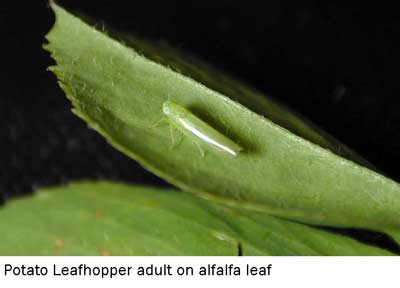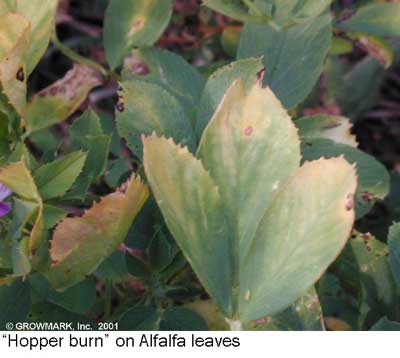
- Potato leafhoppers are a tiny, but significant pest of alfalfa and other crops.
- In alfalfa, potato leafhoppers cause a symptom called "hopper burn."
- Potato leafhopper feeding reduces both quantity and quality of the alfalfa hay crop.
Background
Potato leafhoppers are primarily pests of alfalfa although they feed on a number of other crops, including potato, green beans, dry beans, and soybeans. Soybeans are rarely damaged by potato leafhopper feeding because hairs on leaves and stems provide a level of protection. Potato leafhoppers also feed on a number of trees and ornamental plants, including maples and redbuds. These trees and other plants serve as the initial hosts for the leafhoppers when they first arrive in the spring. Movement to alfalfa and other crops does not occur for several weeks, after one or two generations develop on these alternate hosts.
Potato leafhoppers do not overwinter in the Midwest. Rather, they migrate into the area each spring and then are believed to experience at least a partial return migration in late summer and fall of the year. The migrating leafhoppers typically arrive in May but do not greatly increase in numbers until hot, dry weather develops, usually by mid to late June or early July. This is believed to be partially because of the increase of amino acids in plant sap during hot, dry weather and also because insect-pathogenic fungi are not as active.
Description / Biology
Potato leafhopper adults are tiny (1/8 inch long), pale green, slender, wedge-shaped insects. Adults have wings and are fairly strong flyers for their size. During migrations, the leafhoppers are often aided by favorable winds. The immature stage, or nymphs, are wingless, lime green, versions of the adults. While adults and late stage nymphs usually hop when disturbed, the younger nymphs scurry around, sometimes sideways, like little crabs.
Adult female potato leafhoppers typically live for about 30 days and deposit around 200 eggs, each, over their lifespan. Females have a knife-like ovipositor and insert eggs into plant tissue. Development of leafhoppers from egg to adult takes about 3 weeks. Potato leafhopper generations overlap through the summer. Under optimal conditions, leafhopper populations can double in size in a week to 10 days.
Damage & Management
Potato leafhoppers damage host plant tissue by removing sap and by damaging tissue with their mouthparts, but much of their damage is caused when feeding enzymes, injected during feeding, cause vascular phloem tissue to constrict. This limits water and nutrient movement in the plant. In alfalfa, this is characterized by a condition called "hopper burn." Tips of alfalfa leaves turn yellow, often in a v-shaped pattern, and a feeding spot in the leaf mid-vein is sometimes visible. Severely affected plants are often stunted. Leafhopper feeding causes immediate impact to alfalfa from loss of both crop quantity and quality. There is also a lasting impact on crop vigor.
Different potato leafhopper thresholds may be used. The following one is fairly simple. Note that a sweep net with 15 inch opening is required for scouting. Take 20 sweeps and average the leafhopper count per sweep. Repeat the sweep sequence in several parts of the field. The following threshold numbers apply to normal alfalfa. An adjustment should be made for glandular haired alfalfa, since higher numbers of leafhoppers are required in glandular haired alfalfa to cause the same amount of damage as is caused to normal alfalfa. Alfalfa varieties with high expression of the glandular hair trait and high levels of leafhopper resistance may require 3 times the number of leafhoppers listed in the following table, or may escape economic damage altogether.
Alfalfa Height (inches) Leafhoppers per Sweep
Under 3 0.2
3 to 6 0.5
6 to 12 1.0
12 or Taller 2.0

